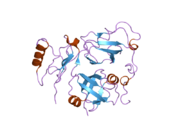| NPLOC4 |
|---|
 |
| Available structures |
|---|
| PDB | Ortholog search: PDBe RCSB |
|---|
|
|
| Identifiers |
|---|
| Aliases | NPLOC4, NPL4, NPL4 homolog, ubiquitin recognition factor |
|---|
| External IDs | OMIM: 606590; MGI: 2679787; HomoloGene: 5403; GeneCards: NPLOC4; OMA:NPLOC4 - orthologs |
|---|
| Gene location (Human) |
|---|
 | | Chr. | Chromosome 17 (human)[1] |
|---|
| | Band | 17q25.3 | Start | 81,556,887 bp[1] |
|---|
| End | 81,648,465 bp[1] |
|---|
|
| Gene location (Mouse) |
|---|
 | | Chr. | Chromosome 11 (mouse)[2] |
|---|
| | Band | 11|11 E2 | Start | 120,271,196 bp[2] |
|---|
| End | 120,328,534 bp[2] |
|---|
|
| RNA expression pattern |
|---|
| Bgee | | Human | Mouse (ortholog) |
|---|
| Top expressed in | - gastrocnemius muscle
- apex of heart
- muscle of thigh
- stromal cell of endometrium
- right testis
- right coronary artery
- islet of Langerhans
- left testis
- left ventricle
- right adrenal gland
|
| | Top expressed in | - spermatocyte
- muscle of thigh
- cumulus cell
- interventricular septum
- ascending aorta
- aortic valve
- spermatid
- supraoptic nucleus
- seminiferous tubule
- lip
|
| | More reference expression data |
|
|---|
| BioGPS |  | | More reference expression data |
|
|---|
|
| Gene ontology |
|---|
| Molecular function | - ubiquitin binding
- protein binding
- metal ion binding
- ubiquitin protein ligase binding
| | Cellular component | - cytoplasm
- cytosol
- nuclear outer membrane-endoplasmic reticulum membrane network
- endoplasmic reticulum
- nucleus
- UFD1-NPL4 complex
- nucleoplasm
- VCP-NPL4-UFD1 AAA ATPase complex
| | Biological process | - error-free translesion synthesis
- retrograde protein transport, ER to cytosol
- Golgi organization
- ubiquitin-dependent ERAD pathway
- proteasome-mediated ubiquitin-dependent protein catabolic process
- negative regulation of type I interferon production
- negative regulation of RIG-I signaling pathway
- ubiquitin-dependent protein catabolic process
| | Sources:Amigo / QuickGO |
|
| Orthologs |
|---|
| Species | Human | Mouse |
|---|
| Entrez | | |
|---|
| Ensembl | | |
|---|
| UniProt | | |
|---|
| RefSeq (mRNA) | | |
|---|
| RefSeq (protein) | |
|---|
NP_060391
NP_001356627
NP_060391.2 |
| |
|---|
| Location (UCSC) | Chr 17: 81.56 – 81.65 Mb | Chr 11: 120.27 – 120.33 Mb |
|---|
| PubMed search | [3] | [4] |
|---|
|
| Wikidata |
| View/Edit Human | View/Edit Mouse |
|

 1nj3: Structure and Ubiquitin Interactions of the Conserved NZF Domain of Npl4
1nj3: Structure and Ubiquitin Interactions of the Conserved NZF Domain of Npl4 1q5w: Ubiquitin Recognition by Npl4 Zinc-Fingers
1q5w: Ubiquitin Recognition by Npl4 Zinc-Fingers 2pjh: Structural Model of the p97 N domain- npl4 UBD complex
2pjh: Structural Model of the p97 N domain- npl4 UBD complex





















